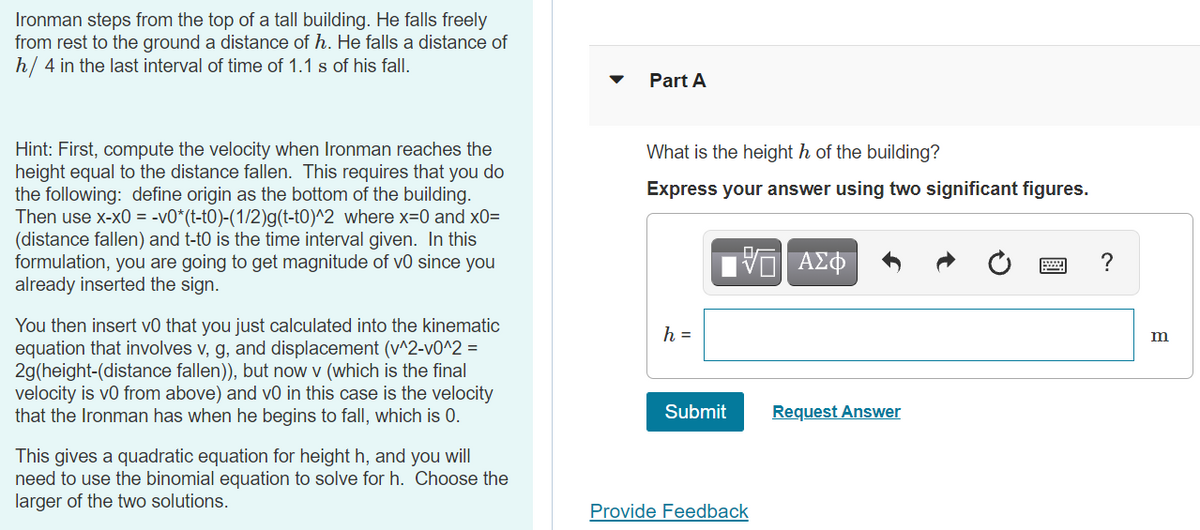Ironman steps from the top of a tall building. He falls freely from rest to the ground a distance of h. He falls a distance of h/ 4 in the last interval of time of 1.1s of his fall. Hint: First, compute the velocity when Ironman reaches the height equal to the distance fallen. This requires that you do the following: define origin as the bottom of the building. Then use x-x0 = -v0*(t-t0)-(1/2)g(t-t0)^2 where x=0 and x0= (distance fallen) and t-t0 is the time interval given. In this formulation, you are going to get magnitude of v0 since you already inserted the sign. You then insert v0 that you just calculated into the kinematic equation that involves v, g, and displacement (v^2-vO^2 = 2g(height-(distance fallen)), but now v (which is the final velocity is vo from above) and vO in this case is the velocity that the Ironman has when he begins to fall, which is 0. This gives a quadratic equation for height h, and you will need to use the binomial equation to solve for h Choose the
Ironman steps from the top of a tall building. He falls freely from rest to the ground a distance of h. He falls a distance of h/ 4 in the last interval of time of 1.1s of his fall. Hint: First, compute the velocity when Ironman reaches the height equal to the distance fallen. This requires that you do the following: define origin as the bottom of the building. Then use x-x0 = -v0*(t-t0)-(1/2)g(t-t0)^2 where x=0 and x0= (distance fallen) and t-t0 is the time interval given. In this formulation, you are going to get magnitude of v0 since you already inserted the sign. You then insert v0 that you just calculated into the kinematic equation that involves v, g, and displacement (v^2-vO^2 = 2g(height-(distance fallen)), but now v (which is the final velocity is vo from above) and vO in this case is the velocity that the Ironman has when he begins to fall, which is 0. This gives a quadratic equation for height h, and you will need to use the binomial equation to solve for h Choose the
Classical Dynamics of Particles and Systems
5th Edition
ISBN:9780534408961
Author:Stephen T. Thornton, Jerry B. Marion
Publisher:Stephen T. Thornton, Jerry B. Marion
Chapter2: Newtonian Mechanics-single Particle
Section: Chapter Questions
Problem 2.6P:
In the blizzard of ’88, a rancher was forced to drop hay bales from an airplane to feed her cattle....
Related questions
Question

Transcribed Image Text:Ironman steps from the top of a tall building. He falls freely
from rest to the ground a distance of h. He falls a distance of
h/ 4 in the last interval of time of 1.1 s of his fall.
Part A
Hint: First, compute the velocity when Ironman reaches the
height equal to the distance fallen. This requires that you do
the following: define origin as the bottom of the building.
Then use x-x0 = -v0*(t-t0)-(1/2)g(t-t0)^2 where x=0 and x0=
(distance fallen) and t-t0 is the time interval given. In this
formulation, you are going to get magnitude of v0 since you
already inserted the sign.
What is the height h of the building?
Express your answer using two significant figures.
?
You then insert v0 that you just calculated into the kinematic
equation that involves v, g, and displacement (v^2-v0^2 =
2g(height-(distance fallen)), but now v (which is the final
velocity is vo from above) and v0 in this case is the velocity
that the Ironman has when he begins to fall, which
h =
0.
Submit
Request Answer
This gives a quadratic equation for height h, and you will
need to use the binomial equation to solve for h. Choose the
larger of the two solutions.
Provide Feedback
Expert Solution
This question has been solved!
Explore an expertly crafted, step-by-step solution for a thorough understanding of key concepts.
This is a popular solution!
Trending now
This is a popular solution!
Step by step
Solved in 3 steps

Recommended textbooks for you

Classical Dynamics of Particles and Systems
Physics
ISBN:
9780534408961
Author:
Stephen T. Thornton, Jerry B. Marion
Publisher:
Cengage Learning

Principles of Physics: A Calculus-Based Text
Physics
ISBN:
9781133104261
Author:
Raymond A. Serway, John W. Jewett
Publisher:
Cengage Learning

Classical Dynamics of Particles and Systems
Physics
ISBN:
9780534408961
Author:
Stephen T. Thornton, Jerry B. Marion
Publisher:
Cengage Learning

Principles of Physics: A Calculus-Based Text
Physics
ISBN:
9781133104261
Author:
Raymond A. Serway, John W. Jewett
Publisher:
Cengage Learning